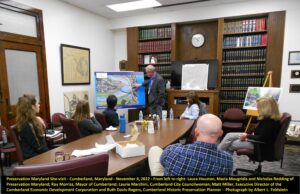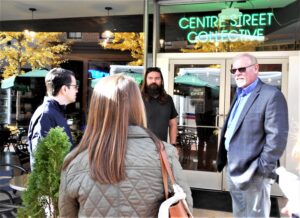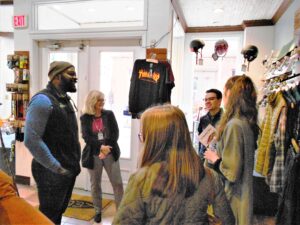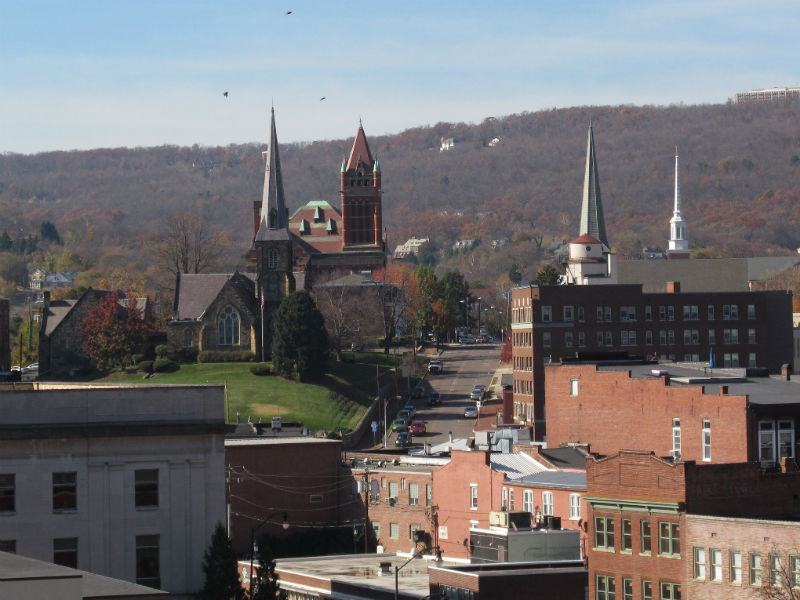Members of the Preservation Maryland team recently had the pleasure of spending a day in the nation’s Gateway to the West. No, not the one in Missouri—the one right here in Maryland that once served as the start of the United States’ first national highway, the western terminus for the C&O Canal, and a hub for railway companies like the B&O Railroad – our very own Cumberland.
The PM crew set out on a crisp and sunny morning to meet with city officials, preservation advocates, and local business owners to hear more about the multifaceted revitalization efforts taking place and yet to come in the historic mountain town. There were many takeaways from the visit, such as the unmistakable sense of pride residents have for their city and its heritage or the commitment from community leaders and members to making Cumberland a place people want to live, work, and play. But what stood out the most—and what Cumberland is proving—is how essential preservation is to a successful recipe for revitalization.
 The group kicked off the visit with a stop at Cumberland’s 1911 neoclassical City Hall
The group kicked off the visit with a stop at Cumberland’s 1911 neoclassical City Hall
for an overview of the investments planned for downtown. The vision includes creating additional housing and enhancing the city’s destination offerings through the adaptive reuse of several historical resources into residential and commercial spaces, restoring green space for broader outdoor recreation opportunities, and supporting those living or working downtown while simultaneously incentivizing others to join through infrastructure improvements.

Centre Street Collective
To see how this vision is being carried out
we ventured into the city center for a walking tour, pausing first to learn about the Centre Street Collective, a “commerce outlet” that provides rentable retail space in the historic commercial core for budding entrepreneurs and/or veteran business owners giving new ideas a try, before making our way to the Rosenbaum, Schwarzenbach, and McMullen buildings on Baltimore Street. One-time department stores built within a span of 15 years around the turn of the 20th century in strikingly different styles and colors, these buildings now serve as anchors in the City’s redevelopment initiative and will provide both new residential units and dynamic commercial space. The McMullen building in particular was recently awarded $464,138.60 in historic revitalization tax credits for its adaptive reuse.

Wheelzup Adventures
The group next wandered over to the former First National Bank & Trust Company building, a ca. 1893 structure that presents a captivating mixture of Romanesque and Byzantine influences and covers an expansive nearly 30,000 sq. ft. As the name would suggest, it operated as a bank and office; however, it now awaits innovative and preservation-minded investors willing to give it a new life. Our next destination introduced us to Wheelzup Adventures, a hub that facilitates outdoor adventures to help locals and tourists take advantage of the natural beauty that surrounds Cumberland. Also while there, we met organizers of the Queen City Film Festival, a four-day event that attracts filmmakers and enthusiasts from around the world. After lunch at a local restaurant, we toured what was originally the US Courthouse and Post Office, a Georgian-Revival building constructed between 1902-1904. As with the First National Bank building, Cumberland is looking to match this property with creative use solutions.
A quick jaunt into Cumberland’s arts district
took us to one of the city’s oldest extant structures, an early 19th century house that served as a comb-making shop and later a blacksmith forge. While modest in appearance, the house clearly has many stories to tell, and stewards of the property are working diligently to find new purpose and investors for this intriguing piece of history. The very eventful day concluded with a tour of the Western Maryland Works Training Centre and Makerspace, an Allegany College of Maryland facility that provides training opportunities focused on machining, welding, and industrial maintenance as well as access to state-of-the-art manufacturing equipment and incubator space.
Study after study has demonstrated that preservation directly stimulates revitalization—not the preservation that is restricted to freezing a building in time, rather, the utilization of existing assets to activate and enliven, to meet needs and improve quality of life.
Preservation can mean the restoration or adaptive reuse of a building, conservation of a landscape, protection of tangible heritage at historic sites and museums, capturing the intangible to prevent its loss from the collective memory, or sharing knowledge of our past through interpretive content and educational material.
These activities enrich the heritage tourism experience so tourists stay longer and spend more. They generate additional revenue, create jobs, provide solutions to many of today’s challenges, strengthen identities, and build pride.
![]() Cumberland is proof of this very fact. Reuse of their iconic buildings is addressing the housing shortage and providing space for businesses to begin or grow, both of which bring in foot traffic and revenue. The work has triggered infrastructure updates, increased job opportunities, and attracted investments. It has renewed interest in the layers of history and heritage present in the town and inspired a deeper dive into the past. In short, prioritizing preservation in Cumberland’s redevelopment planning has jumpstarted community revitalization and set the city on a path rich with potential and energized by palpable forward momentum.
Cumberland is proof of this very fact. Reuse of their iconic buildings is addressing the housing shortage and providing space for businesses to begin or grow, both of which bring in foot traffic and revenue. The work has triggered infrastructure updates, increased job opportunities, and attracted investments. It has renewed interest in the layers of history and heritage present in the town and inspired a deeper dive into the past. In short, prioritizing preservation in Cumberland’s redevelopment planning has jumpstarted community revitalization and set the city on a path rich with potential and energized by palpable forward momentum.
There’s no denying much work lies ahead in bringing out the shine of this Maryland gem. Previously the state’s second-largest city, Cumberland experienced a decline in its economy and population in post-industrial America that has resulted in decades of rebuilding and rebranding. But not for nothing is it called the Queen City. Cumberland earned this nickname in its earlier days for its vibrancy and prominence, and these traits clearly remain. The historic town has all the necessary ingredients to reach its full potential as a desirable destination for both residents and visitors, with its distinct and remarkably varied built environment, abounding natural resources, existing ties to its history, public space to activate for community events and engagement, and capacity for increasing diversity in career and housing options. And by using preservation as the binding agent, the results will be a healthier and more robust community where people will in fact come for a visit and stay for life.

